Week-to-Week: Sinners' Box Office vs. the Asterisk People
Kristen Warner returns to break down the discourse around the contentious performance of Ryan Coogler's latest film

Welcome to Week-to-Week, the somewhat weekly-ish newsletter of Episodic Medium, where I reflect on the state of the media industries. To receive future newsletters and learn more about our weekly TV coverage for paid subscribers, sign up below.
Back in December 2023, I was joined by Cornell University’s Kristen Warner to reflect on the discourse surrounding the box office performance of The Marvels, which had become a flashpoint for an ongoing struggle between the trade press and observers of issues of representation within the film industry.
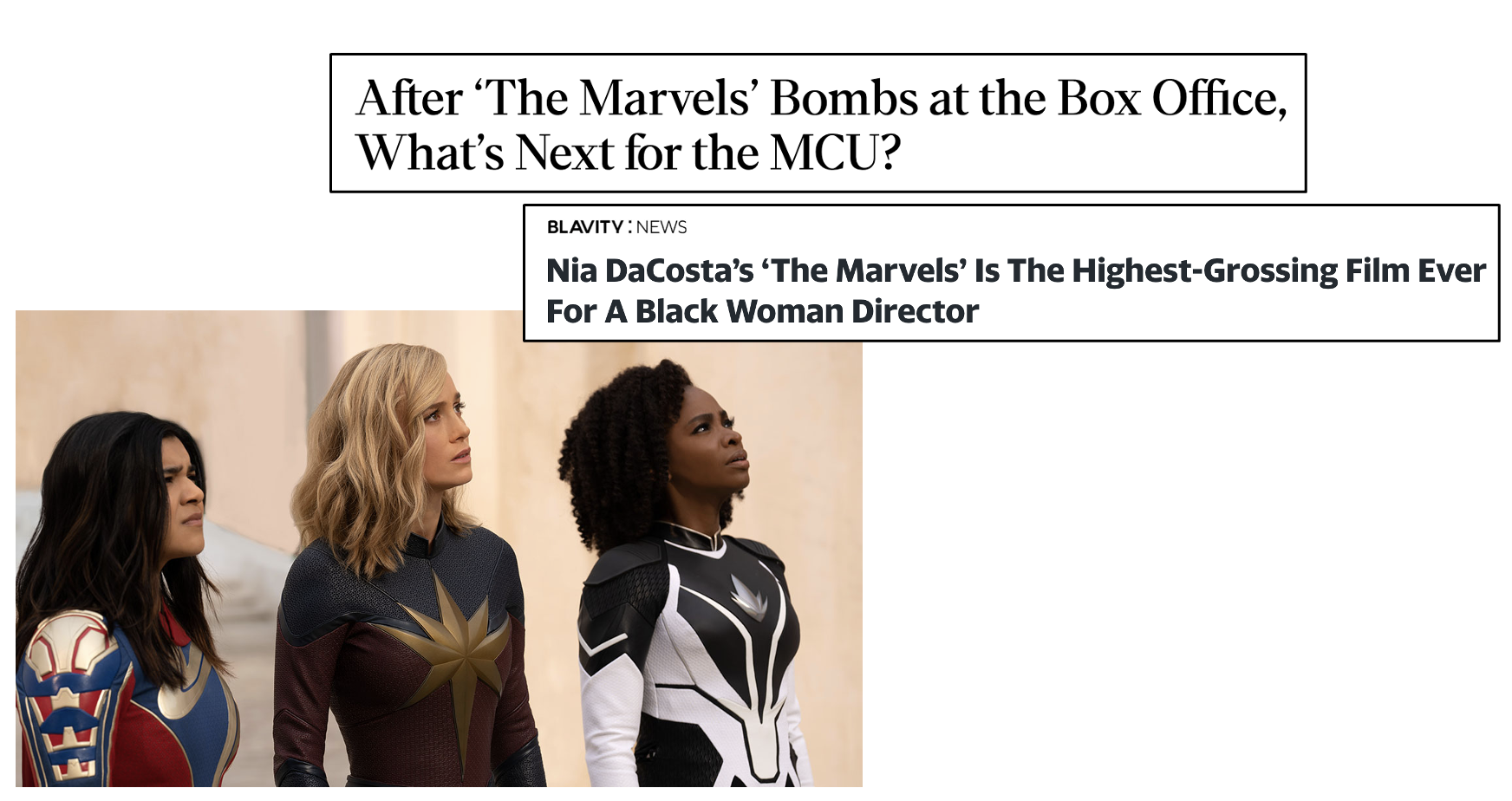
The tension we observed at the heart of that conversation was that the facts of a film’s financial performance are never going to be filtered through the trade press with space for the feelings of underrepresented viewers, and that while there’s room for the trade press to understand the nuance of a film’s reception, it doesn’t change the dollars and cents that drive the industry.
And while we covered a lot of general ground in that newsletter, part of our central thesis was that the context of any given case should matter more than the surface-level discourses around a particular film. While we can broadly say that box office reporting represents a space of conflict between facts and feelings, those facts are variable in a way the feelings aren’t, meaning that each new example becomes a distinct dialogue. Which is to say that neither of us were shocked when we found ourselves having familiar conversations over the past week as Ryan Coogler’s Sinners became the latest film to spark controversy over how its $63m worldwide opening weekend was covered by journalists.
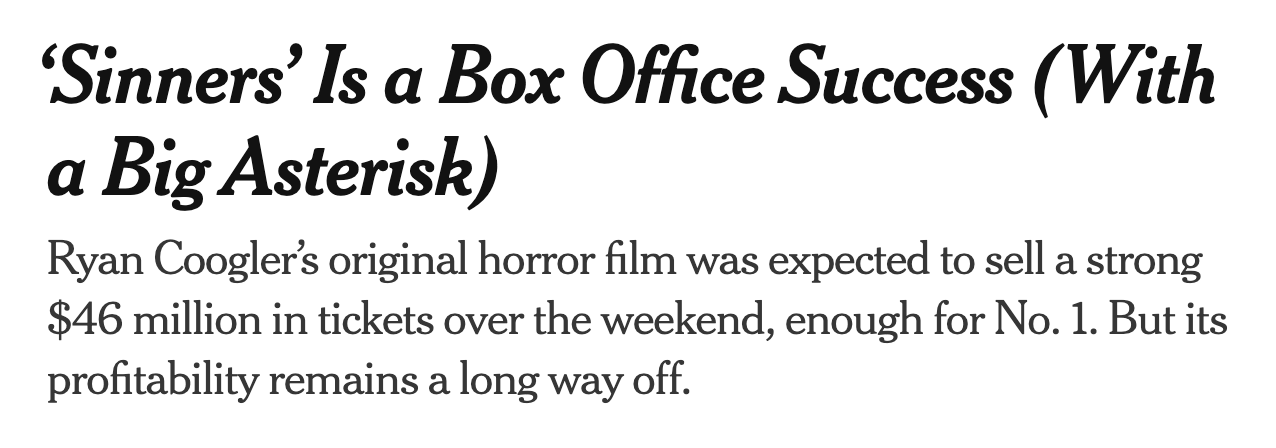
Before I bring in Kristen for our sequel newsletter, a few facts up front. Warner Bros. produced Sinners at a reported cost of $90m, a little over double the budget for his last non-Marvel production, Creed (and reports suggest the film actually end up costing close to $105m). What’s a little different in this case is that Warner Bros. cut an almost unprecedented deal with Coogler that gives him first-dollar gross and the rights to the film after 25 years, which is either a boon for creative freedom or the death knell for studio filmmaking depending on who you ask. It’s a new wrinkle for a film that otherwise taps into two existing box office conversations: the fate of original films in an I.P.-dominated marketplace and the underestimation of Black-led films (particularly at the international box office). I will also note that we started writing this before second weekend returns came in showing only a 6% decline, which clearly solidified the film’s domestic success.
And now, Kristen, it’s time we dive in: where do you think we need to start this conversation to best explain what’s been happening online over the past week and a half?
Kristen Warner: I’ve been summoned by the internet again. Sighs. First, as always it’s important to remind our friends that the facts and educated speculating we discuss here do not invalidate the feelings you mentioned up top. So much of the discourse around the audience versus the asterisk people (aka box office press) can be summed up around the word “deserve.” Fans of the film believe Sinners deserved to be written about with the same glee and excitement as films directed by white filmmakers while the asterisk people imagine their numbers analysis is both a micro and macro game for comparisons.
Headlines are a notoriously problematic art form that will most assuredly lead to confusion, rage, and frustration for the reader. Those feelings generate clicks and those clicks generate more headli—y’all are savvy and know how this works. But yeah, the result is that now the question around Sinners has little to do with the questions it needs to answer—like Coogler’s team’s smart negotiations in the bidding war for the film or the question that both Myles and I have wondered about if the movie is prestige or blockbuster or blockbuster-y prestige enough to make the 10th or 11th slot at the Oscars next year. Instead the last week has concerned the amorphous concept of box office as synecdoche for auteur respectability and worthiness from the asterisk people.
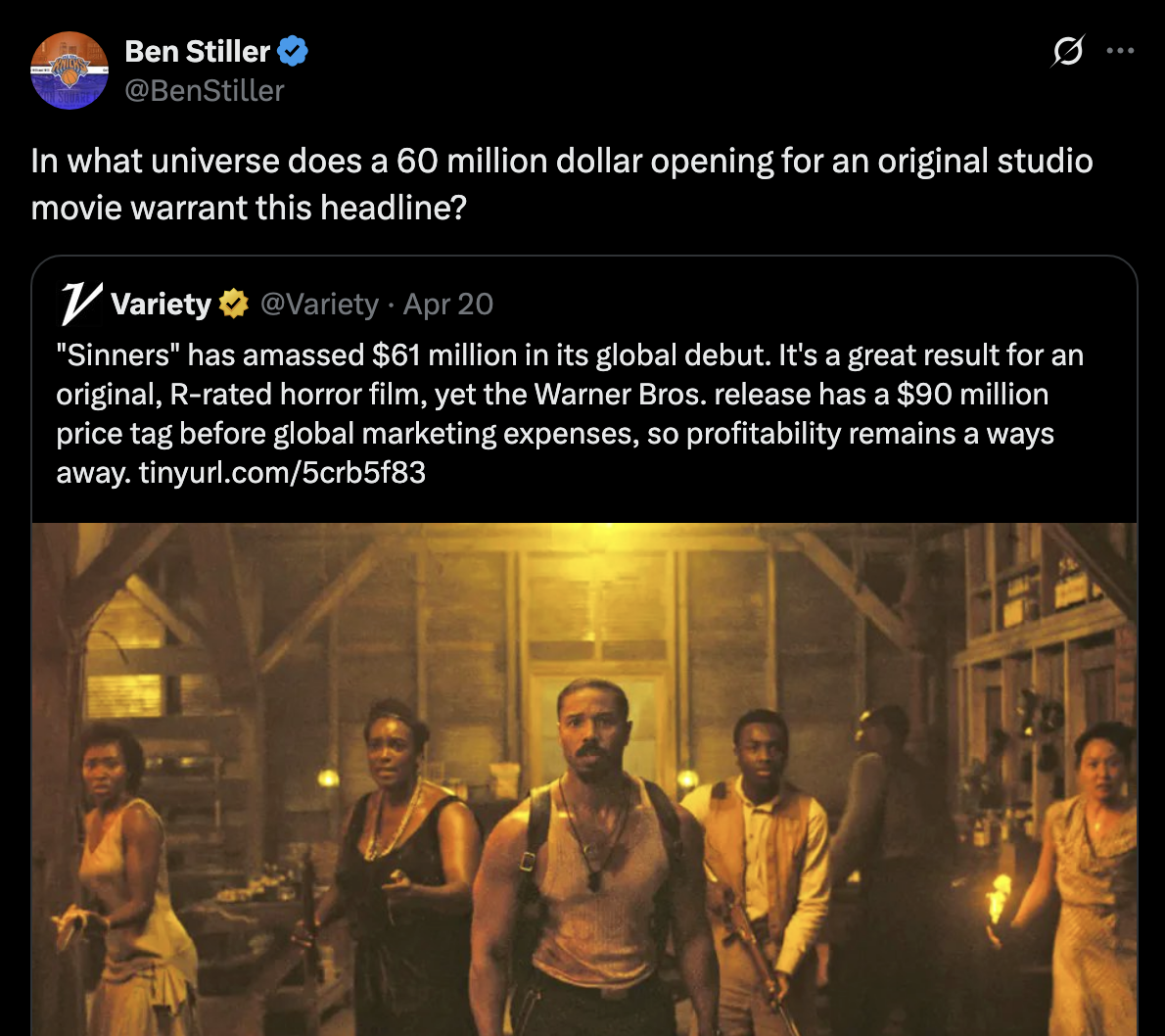
And listen, if Ben Stiller (who knows how this game works so his meandering into this conversation is not actually helpful) is popping up telling the asterisk people to “put respeck on Sinners name,” I mean…yeah, that’s a news cycle worth of stories to report. However, it’s time for that eternal downer moment: Worthiness and being deserving, while important for the symbolic meaning and the “feel good” of success, are not the key indicators we think they are. Because what the frustrated audience means by “compare Sinners to Once Upon a Time in Hollywood” is to treat Coogler like you’d treat Tarantino. The latter movie earned less (domestically) then the former so can’t you see how adding an asterisk to its success is putting a thumb on the scale of value?!
And don’t you know that :whispers: if we don’t make this movie as big as ever and if you don’t frame this movie as the big deal it is there won’t be anymore like it! I know that’s the core anxiety at work here but let me dispel this for you quickly: it doesn’t matter…unless you’re Ryan, Barry, Steve, and sometimes Spike and Ava, they won’t hardly make those movies anyway. ;)
To the other point. Well. I hate to break it to you friends. Even though the asterisk people have no bedside manner they might be…right.
MM: Look, we don’t like it! And there’s no really good way to interject into a discourse like this one without seeming like the bad guy, or at least a Friend of the Asterisk People. But the simple truth is that the frustrated audience and the asterisk people have something in common: they both rely on imperfect “comparatives” to support their narratives.
The Once Upon A Time in Hollywood comparison is a great example of this. It started simply because the two films both include copyright deals for their directors and have the same budget: $90m. So, in the eyes of the frustrated audience, this was a clear sign that publications like The New York Times were judging Sinners by a different set of standards: look at this other movie that made less—on fewer screens—that didn’t face the same scrutiny!
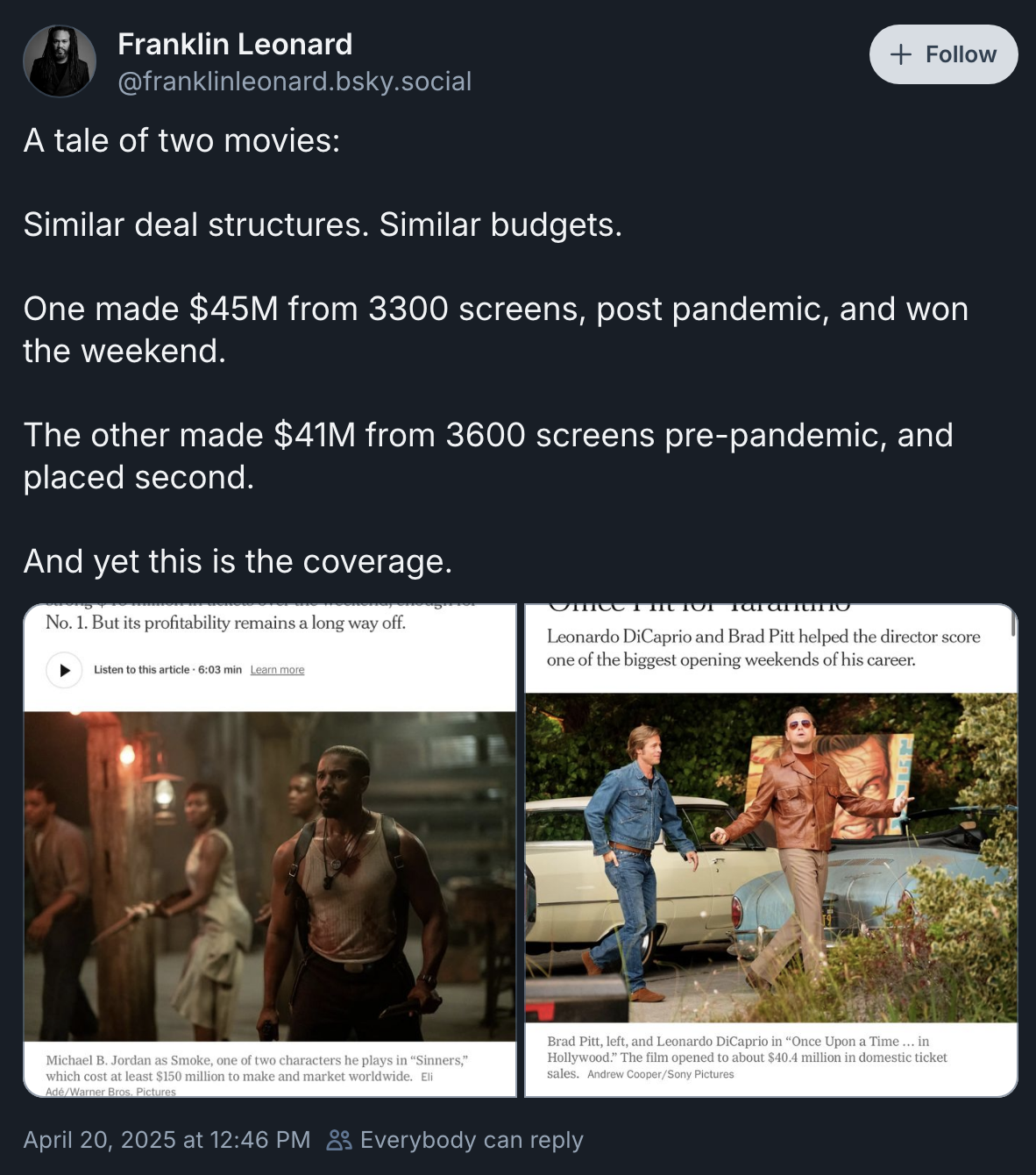
But although they share some similarities, these are not necessarily comparable films. Once Upon a Time in Hollywood was an overperformance for an older-skewing film driven by its director and stars, but Sinners has a genre angle that puts it into a different conversation. Those facts—among others I know you want to get into, KW—matter if we’re going to start making 1:1 comparisons.
Now, to be clear, the asterisk people are far from perfect, but I’d argue that they have a system of choosing comparatives that is rooted in a more grounded—if deeply cynical—take on Hollywood accounting. Before its release, Deadline pitted the film against Jordan Peele’s Nope, and honestly that makes sense: it’s also an original, horror-adjacent film from a Black filmmaker with an auteur reputation and a history of domestic-skewing films. And so when they point out that Sinners carries an extra $20m in its budget, that’s a fair point, and helps explain why trade reporting wasn’t rhapsodic based on Sinners’ $48m opening weekend (compared to Nope’s $44m). At least based on the opening weekend results, putting an asterisk on Sinners is a fair assessment of its performance.
Now, as the film overperforms in its second weekend as we write this (with an extremely uncommon 6% drop domestically), the trades are wildly changing their tune, and the frustrated audience is logically pointing to this as a sign of capitulation: “look what we made them do! And while I do think there’s some correction happening here, this is also the truth of the asterisk people: they are an ephemeral entity, always willing to follow the numbers when the tides turn. Their job is to explain the moment in time we’re in, starting with predictive reports (based on tracking), continuing with early returns (estimating based on probabilities), and then adjusting day-by-day from there. Now, this gets awkward when weekend results come in and the genre of writing shifts from daily reactions to definitive headlines, but it reminds us this is a genre of writing wildly inconsistent with feelings. I understand where the frustration comes from, but there comes a point where we need to accept that just because they step on some land mines doesn’t mean they’re always going in the wrong direction.
KW: :Nods along writing in my notebook.: Myles, if I may return to that Once Upon a Time in Hollywood (OUATIH) example for a beat? The other thing that the asterisk people aren’t clarifying but that is very much a part of their tracking has to do with, well…white people. Specifically white people in other countries—or territories, if we’re using industry jargon. So an interesting data point came through some of the reporting a few days ago that is really important to consider. If y’all remember the first time Myles and I joined in this box office conversation, we walked through Steven Soderbergh’s box office math lesson from his 2014 State of Cinema keynote and how when trying to ascertain what “profitability” means for a movie, you can’t just look at the production budget being recouped as proof of success. No, you gotta consider that exhibition takes a cut, you gotta consider the prints and advertising (marketing and promotion budget), AND you gotta consider the international distribution numbers.
That $90m budget—or $100 or $110m based on the reporting that Coogler went over budget and had WB take the $20m over costs out of his first dollar gross and backend profits margins—means that the movie needs to gross somewhere between $240-$300m to be “in the clear.” But an interesting thing happened: Warner Bros. told the analytics asterisk people that that number wasn’t right. They told Vulture that Sinners only needed to gross $170m GLOBALLY to recoup costs. Added to that, they said that the print and advertising costs floating between $75m and $85m were already absorbed into that gross.
Friends, that makes absolutely no god–Myles, can I curse? I’m just gonna go ahead and do it: that makes not one bit of goddamn sense. The math isn’t mathing. $170m is not even double the budget! How could that be… Well it could if…well…if…they’re not counting on the international box office to perform all that well. It seems like WB skipped right past international and onto PVOD, SVOD and network windows.
And that’s…that’s a big damn deal. To the point about marginalization of underrepresented groups in film, it’s a long storied note about Hollywood that when it comes to Black films they traditionally place a $0 in the international category believing that regardless of the subject matter, Blackness doesn’t travel. This is nonsense logic and can be overcome with marketing and strategies like using the A-level film festival circuit to promote your movie and get the folks on all the other ponds excited.
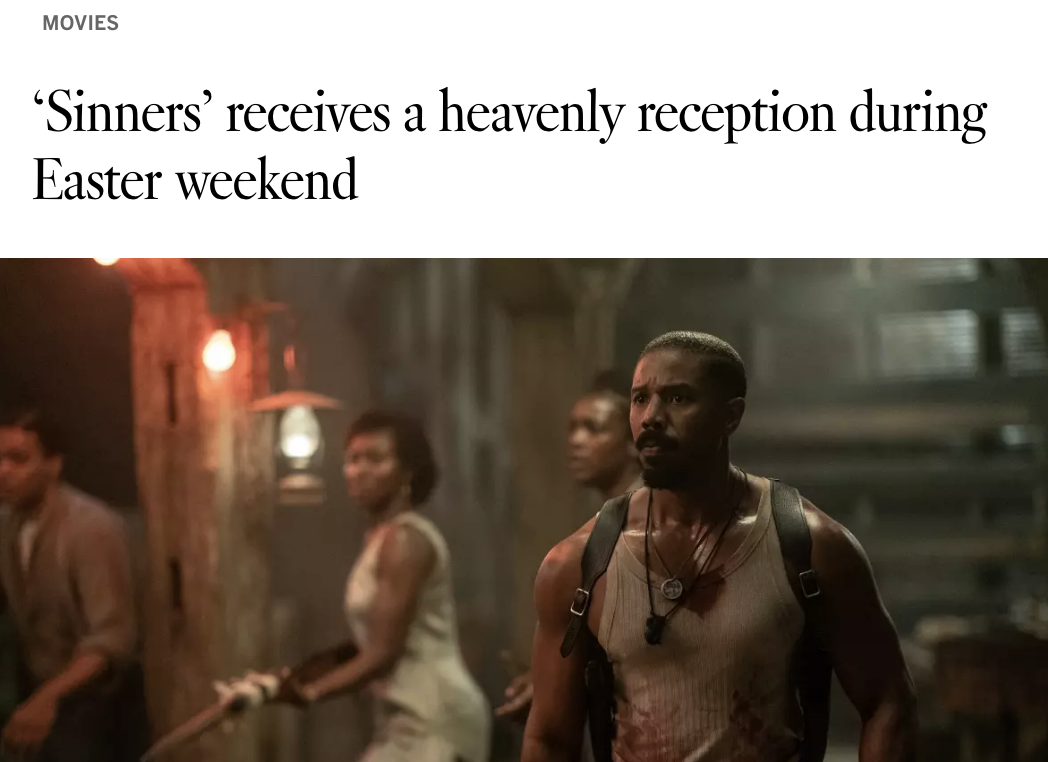
Opting for an Easter release is a smart DOMESTIC strategy as was the word of mouth advertising campaign the movie opted for. But for international? You’d need to push that release to May for Cannes or August for Venice/Telluride or September for Toronto. But that option didn’t happen. Maybe because WB has some tentpoles they gotta set up for summer release not to mention the OTHER movie they’re putting their money behind that stars OUATIH’s Leonardo DiCaprio (Side note: I’ve never written his name out before and had to look up how to spell it. Always firsts on Episodic Medium!). While pushing the film to a summer/fall release would have been tricky for the studio, it would have at least given them a good shot at expanding the international box office.
As it is, in comparison to the domestic box office, Sinners international dollars kinda suck a little bit. While the strong domestic hold confirms WB will get to that imaginary $170m number, domestic numbers, the global tracking suggests the movie won’t overperform internationally and might stall out before a more rational profit threshold is reached. So, this is why the asterisk people are right, unfortunately—the movie will be a success but with the caveat of WB taking a small haircut on the international profit. And this is why the comparison to OUATIH should be handled with a little more caution. First, OUATIH premiered out of competition at Cannes–international market. Second, the movie may have underperformed Sinners' first weekend (and as noted above, Sinners even beat it with fewer screens so…that’s cool, right?) domestically but internationally? Respectfully? OUATIH took a bite out of Sinners. The match up in territories like France, the UK, Australia, and Spain are kinda staggering when you put the movies in comparison to each other. When OUATIH completed its theatrical run, the film grossed nearly $235m overseas. The numbers do not yet suggest that Sinners will have a run of that sort what with the first weekend gross of $15m (even with a slim second weekend drop).
What’s the point? WB essentially handicapped Sinners by boxing its success SOLELY within the confines of domestic terms. This movie will earn $170m–Buddy Guy willing it will continue to “smash” records and get to $250m. [Editor’s note: After the second weekend drop, it’ll probably happen] It will beat OUATIH’s domestic box office for sure. But the long tail or whatever is not going to generate the actual money needed to make it a true winner in the ways that these movies need to be without also having the phrase “loss leader” attached to it in the accounting department. Remember what I said earlier about the traditional lore of international sales believing Black films don’t travel? It seems like WB bought that logic and —instead of fighting against that trope—have used it to spin a yarn that the domestic split is just fine.
Hence, the asterisk. The racial microaggression is coming from inside the house, friends—not the asterisk people. Could they have thought more carefully about those headlines and stuff? Definitely. But your problem is with a studio that chose to get this movie out of the way to make room for the others and taking the success as an omen for the future as opposed to proving that Black film CAN travel. Hell, there’s Riverdance in the movie! Of course it can travel.
And here’s how you will be able to tell if they handicapped it: when DiCaprio and Paul Thomas Anderson’s—who has never in his entire fucking brilliant genius auteur career helmed a $130m movie—One Battle After Another comes out in September, will the studio say it only needs to earn $250m with prints and advertising absorbed to be in the clear or will they expect that movie to gross $320m-$380m? It’s a September release so its strategy will likely be Venice or Toronto/maybe Venice AND Toronto, and a sneak peek at Telluride just to please the patrons. September is a hell of a time to test blockbuster prestige movies like that but…I’d bet the international audience is going to be engaged in this movie in ways they weren’t with Sinners.
And even if One Battle After Another fails—and I mean…it could really fail commercially—the fact that WB took it out in the way that showed they believed the movie could travel indicates something that the folks fussing at the asterisk people have not yet realized.
And that is the point.
MM: When you first told me that WB itself was touting the $170m number, I was floored. Even if we accept that the math is funky, it goes against a critical dimension of Hollywood accounting, which is making movies that were clearly profitable look like losses to avoid paying the people involved. Ed Solomon posts about Sony’s claim Men in Black made no money every year, which gives a good indication of how weird this is.
But it underlines your point that the asterisks are being generated by the studio itself in this case, both in the context of its release and in their response to the asterisks from the press. Would they be doing the same if they hadn’t handicapped the film’s international performance? Is this about saving face for the executives who made the much-talked about rights deal with Coogler? And, in what is my best explanation for their willingness to fudge the numbers in the opposite direction than they usually do, are they willing to do this because Coogler’s negotiation includes first-dollar gross, meaning they have to pay him regardless of whether the film turns a profit?
I listened to an episode of Matt Belloni’s The Town where Franklin Leonard—who, as noted above, really amplified the OUATIH narrative—pushes back against the asterisk people’s reliance on anonymous agents and studio executives peddling the same lore about Black film in international markets. I had read about the podcast on BlueSky, where it was framed as an epic smackdown, and it’s true that Leonard successfully breaks down the failure of marketing in selling Black film overseas (although, if I may say so, not as well as you did just now). But while Belloni steps on his own feet trying to play studio’s advocate, I’d argue the real tension here is the question of whether the trade press has a responsibility to educate on these issues. We know to read this reporting as a mirror of broken industry logics that unfortunately drive decision-making, but can we imagine a version of the trade press that deconstructs those logics more consistently?
Belloni opens the podcast with the assertion that the narratives created by box office reporting “matter” for two reasons. The second is that the industry makes decisions based on how films perform financially which, yes, obviously. But his first reason was that the audience makes decisions on what to see based on it, which…what? If I could make any proclamation here, it’s that whether or not a film is asterisked in its box office reporting is not a matter of consequence to the moviegoing public. Clickbait social media accounts shouldn’t be out here blatantly making up facts for engagement to try to manipulate people’s feelings.
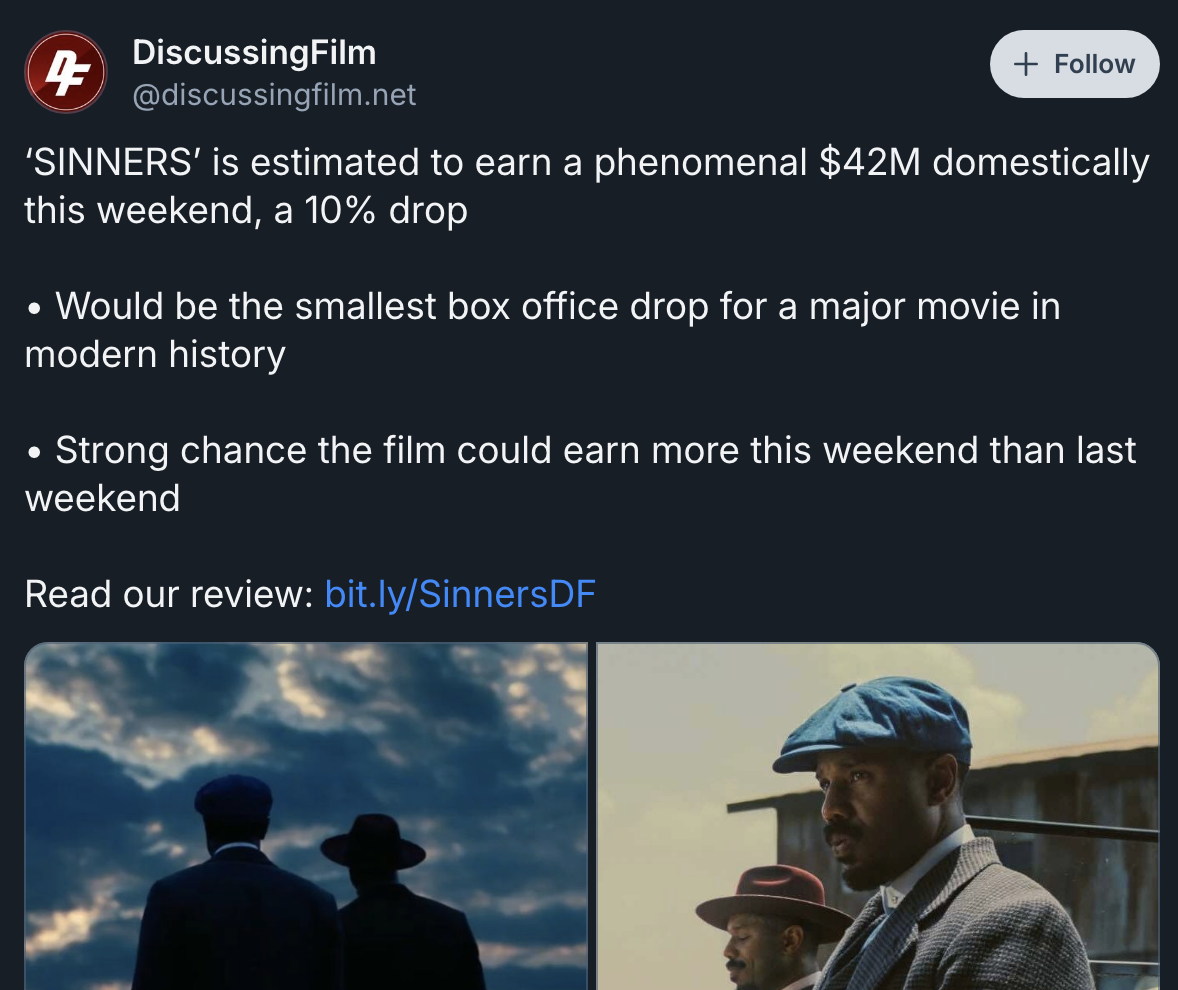
The industrial logics we can glean from box office reporting are valuable insights into better understanding the decision-making of studio executives, but audience decision-making should not be tied to how “boffo” a film is deemed. As much as I wish we had a rigorous trade press that used pedagogy as its framework, we don’t, and so I worry sometimes how much oxygen we use up trying to judge a trade press for doing what it was designed to do: write about industry for industry, in ways that will never account for the feelings of an average person who liked a movie they saw.
KW: Can you imagine a bunch of industry box office reporters trying to do the work that pays them which, as you clearly note, is for industry workers as the primary audience, having to write more grafs that clarify, contextualize, and historicize the tracking data about every single movie they are assigned? Do…they…would they know how? Like..where would they learn! Who watches the watchmen!
I kid with some of the hyperbole because I do think that it’s not uncommon for asterisk people to find themselves in this spot where discerning audience members wish to understand the sausage making and they are unprepared to explain; perhaps it would be helpful to at least have a white paper general explainer of things that they can point to as a reference guide. It wouldn’t explain things like context or particulars about industry logics and myth—which would probably get them fired all while still being unsatisfying for the interested invested lay reader on TikTok, but I digress.
It’s just funny to me because throughout this conversation, neither of us have said one peep about the goodness or badness of the movie. Neither of us have offered a word of conjecture concerning quality of substance. Because talking about box office logic doesn’t require us to do so. If we liked Sinners or not is not part of the equation to identify the formula of performance and the weird business move we clocked from that studio. Hell, that move, while problematic as hell, doesn’t even mean WB didn’t love or believe in Sinners. It means you as fans of the movie are invested in this because you are fans of the movie; not the business.
Facts and feelings. The latter brought you enough curiosity into trying to decipher the facts but it doesn’t supersede the reality of that data.
Trust me. If it did, we would have had a lot more contextualized data around the blockbuster success of Paul Blart: Mall Cop (2009). Was it a recession indicator or proof that Kevin James was bound to be a movie star?
Facts or feelings.
You can follow Kristen on Bluesky for more of her insights.





Comments ()